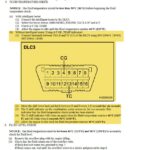Are you tired of seeing that dreaded “check engine light” illuminate on your dashboard? Understanding what’s wrong with your car doesn’t have to be a mystery. The Autel AutoLink AL319 OBD2 Scanner is a popular entry-level tool designed to help car owners and DIY enthusiasts diagnose basic car problems quickly and easily. In this in-depth review, we’ll delve into the features, benefits, and potential drawbacks of the Autel AL319 to help you decide if it’s the right OBD2 scanner for your needs. We’ll go beyond the basics to provide a comprehensive look, ensuring you have all the information you need to make an informed decision about this handy automotive tool.
Unboxing and First Impressions of the Autel AL319
Upon receiving the Autel AL319, the first thing you’ll notice is its compact size. It’s significantly smaller than some older OBD2 scanners, making it incredibly portable and easy to store in your glove compartment. The device feels robust despite its size, and the bright color screen is immediately eye-catching. The interface is minimalist, featuring only three buttons. While this simplicity is generally a plus, it does present a slight initial learning curve in navigation. Connecting the scanner to a vehicle’s OBD2 port is straightforward, and the device boots up remarkably fast, getting you ready to diagnose your car within seconds.
Alt text: Front view of Autel AutoLink AL319 OBD2 scanner showcasing its color screen and button interface.
Key Features and Benefits of the Autel AL319 OBD2 Scanner
The Autel AL319 packs a surprising number of features into its small frame, making it a valuable tool for basic car diagnostics:
- Read and Erase Diagnostic Trouble Codes (DTCs): The primary function of the AL319 is to read and clear generic OBD2 codes, effectively turning off that pesky check engine light. It also detects pending codes, giving you an early warning of potential issues.
- Emission Readiness Test: A dedicated I/M readiness button allows for quick checks on your vehicle’s emission system status. Color-coded LED indicators (Green, Yellow, Red) clearly show if your car is ready for emissions testing, saving you time and potential headaches.
- Manufacturer-Specific Codes: Beyond generic OBD2 codes, the AL319 can also detect some manufacturer-specific codes. If detected, it prompts you to select your vehicle’s make and model for more specific diagnostics. While it focuses on basic engine codes, this feature adds a layer of depth not always found in entry-level scanners.
- Live Data Stream: Accessing live OBD2 data is crucial for in-depth troubleshooting. The AL319 provides real-time data on essential engine parameters like coolant temperature and O2 sensor readings. The refresh rate of the live data screens is impressively fast and smooth, making this feature genuinely useful for monitoring your engine’s performance.
- Broad Vehicle Compatibility: The Autel AL319 is designed to work with most OBD2 compliant vehicles, including a wide range of makes and models from Honda to VW. This broad compatibility makes it a versatile tool for households with multiple vehicles or for those who work on different car brands.
- User-Friendly Interface: While navigation takes a moment to learn, the overall menu system is fast and responsive. The bright color screen enhances readability in various lighting conditions.
Alt text: Autel AutoLink AL319 OBD2 scanner connected to a car’s OBD2 port during a diagnostic scan, illustrating practical usage.
Minor Drawbacks to Consider
While the Autel AL319 is a highly capable OBD2 scanner for its price point, there are a couple of minor drawbacks to be aware of:
- User Interface Navigation: The three-button interface, while simple, lacks a dedicated “exit” button. Navigating back to previous menus requires using the scroll button to find the “return” option, which can be slightly unintuitive initially. However, this becomes less of an issue with familiarity.
- Cable Length: The attached cable is approximately 2 feet long, which may be shorter than desired in certain situations. For example, when using a lift or trying to observe live data while driving, a longer cable would offer more flexibility. For basic code reading in a parked car, the cable length is generally sufficient.
These minor points are overshadowed by the scanner’s robust feature set and reliable performance.
Who is the Autel AutoLink AL319 For?
The Autel AL319 is ideally suited for:
- Home Car Owners: For everyday car owners who want to understand and address basic check engine light issues without immediately visiting a mechanic.
- DIY Enthusiasts: For those who enjoy basic car maintenance and repairs and want a tool to diagnose engine-related problems themselves.
- Budget-Conscious Buyers: For individuals seeking an affordable yet capable OBD2 scanner that provides essential diagnostic functions.
If you require advanced diagnostics such as ABS, Transmission, or Airbag system scanning, or more in-depth features, you might need to consider a more advanced scanner. However, for fundamental engine code reading, emission checks, and live data monitoring, the Autel AL319 is an excellent choice.
Conclusion: A Top Pick for Basic OBD2 Scanning
In summary, the Autel AutoLink AL319 OBD2 scanner stands out as a highly recommended portable code reader, particularly for its ease of use, speed, and essential features. Despite minor navigation and cable length considerations, its strengths in fast boot-up, clear display, emission readiness testing, manufacturer-specific code detection, and responsive live data make it a valuable tool for diagnosing basic car problems. If you’re looking for a reliable and affordable entry-level OBD2 scanner to keep in your car, the Autel AL319 is definitely worth considering. It’s a practical tool that empowers you to understand your vehicle better and potentially save money on unnecessary trips to the mechanic for simple diagnostic checks.
